Hey there, fellow fish enthusiast! I’m thrilled to share everything I know about a truly delightful species – the Corydoras Catfish, or simply Corys. These little guys belong to the genus Corydoras, part of the family Callichthyidae, and the order Siluriformes. They’re a fascinating bunch, with over 170 recognized species, each with its own unique charm. And guess what? They’re all from South America! Isn’t that cool?
Now, let’s talk about where these Corydoras Catfish love to hang out. Picture slow-moving rivers and tranquil streams – that’s their natural habitat. But here’s the kicker, they’re not your typical fish. They’re bottom-dwellers, spending most of their time near the substrate. And every so often, they’ll dart to the surface to gulp some air. Yes, you heard that right! They have a specialized intestinal system that lets them extract oxygen from the air. Talk about a party trick!
Corydoras Catfish has been a hit in the aquarium world for quite some time now. Their peaceful nature, coupled with their active behavior, makes them a joy to watch. Plus, they’re social fish, so they love being in groups. Imagine having a little squad of Corydoras Catfish in your tank, sifting through the substrate and just having a good time. Sounds fun, doesn’t it?
While Corydoras Catfish are not considered rare, some species are less common in the aquarium trade. Factors like breeding difficulty or less accessible natural habitats can make certain species harder to find. But don’t let that deter you! The thrill of finding and caring for these less common Corydoras Catfish species can be quite rewarding.
Did you know that Corydoras Catfish have a unique defense mechanism? When they feel threatened, they can lock their spines in the upright position. And they’re one of the few fish species that can blink their eyes. Plus, they make a clicking noise when they eat, which is thought to be caused by their pharyngeal teeth grinding together. Fascinating, right?
And for some fun facts – the name “Corydoras” comes from the Greek words ‘kory’, meaning helmet, and ‘doras’, meaning skin. Some species of Corydoras Catfish have even been known to live for over 20 years in captivity. Now, that’s a commitment!
The history of Corydoras Catfish in the aquarium trade goes way back. They’ve been popular for many decades, and it’s easy to see why. The first species was described way back in 1836, and new species continue to be discovered today. So, who knows? You might just be the next person to discover a new species of Corydoras Catfish!
So, there you have it, everything you need to know about the delightful Corydoras Catfish. Whether you’re a seasoned aquarist or just starting out, these charming little fish are sure to bring joy to your aquarium. Happy fishkeeping!
Table of Contents
Price, Common Names, and Variants of Corydoras Catfish
Price
The price of Corydoras Catfish can vary significantly based on the species, age, size, and coloration. Here’s a general idea:
- Common Corydoras Catfish: These are usually the most affordable, often priced between $5 and $10 per fish. This includes species like the Bronze Cory and Peppered Cory.
- Rare or Uncommon Corydoras Catfish: These can be more expensive due to their rarity or unique coloration. Prices can range from $15 to $30 or even higher per fish.
- Albino Corydoras Catfish: These are typically priced similarly to common Corydoras, often between $5 and $10 per fish.
Please note that prices can vary based on your location and the specific retailer.
Common Names
Corydoras Catfish are known by several common names, often based on their appearance or behavior. Some of these include:
- Corys: This is a shortened version of their genus name and is widely used in the aquarium hobby.
- Armored Catfish: This name refers to the bony plates that cover their bodies, providing a form of protection.
- Plated Catfish: This is another name that refers to their armor-like body covering.
Variants
There are over 170 recognized species of Corydoras Catfish, and many of them are popular in the aquarium trade. Some of the most well-known variants include:
Bronze Cory (Corydoras aeneus)
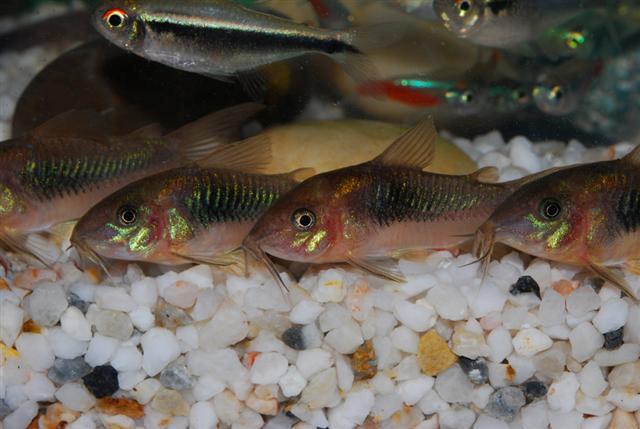
The Bronze Cory, also known as the Green Cory, is a hardy and adaptable species that’s perfect for beginners. Its body shimmers with a metallic bronze sheen, hence the name. This variant is widely distributed and is one of the most common Corydoras in the aquarium trade.
Peppered Cory (Corydoras paleatus)
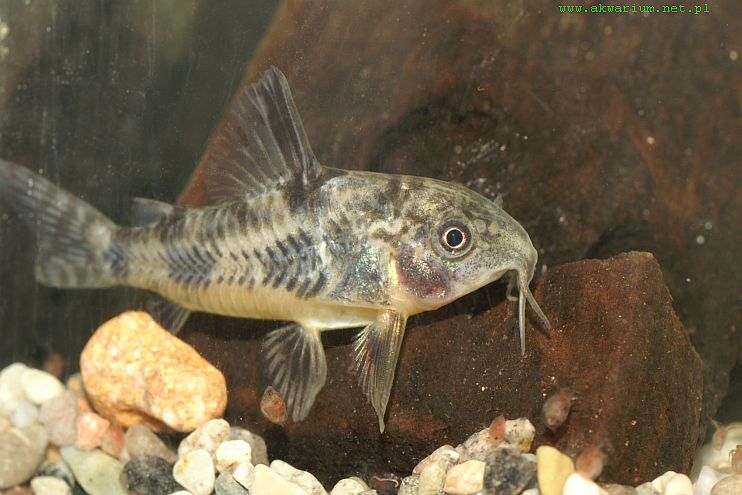
The Peppered Cory is a captivating species known for its speckled, pepper-like pattern across a greyish-to-greenish body. This pattern provides excellent camouflage against the riverbed in its native habitat. It’s a robust species that can tolerate a wide range of water conditions.
Sterbai Cory (Corydoras sterbai)
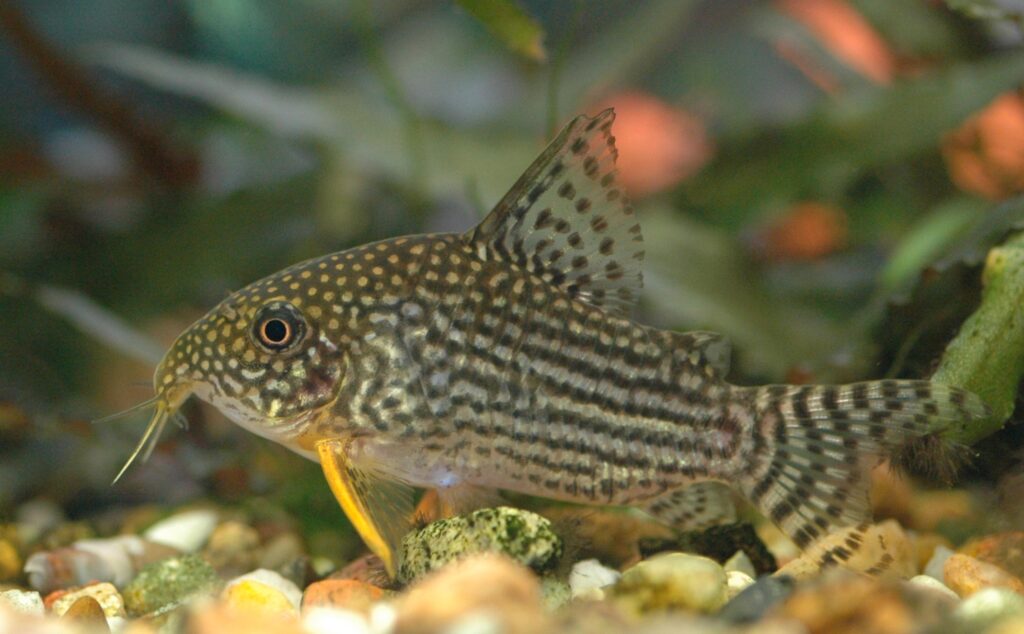
The Sterbai Cory is a standout species admired for its striking appearance. It features a dark body adorned with white, star-like spots and contrasting bright orange pectoral fins. This variant is a bit more heat-tolerant than other Corydoras, making it a popular choice for Discus tanks.
Albino Cory
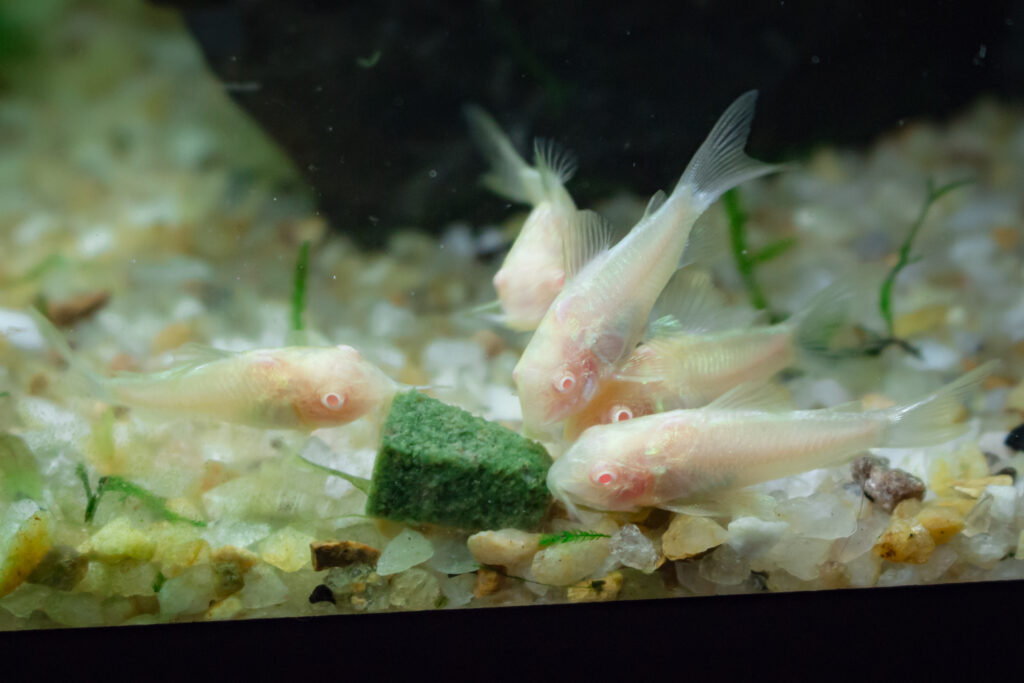
The Albino Cory is a color variant of the Bronze Cory. It lacks pigmentation, resulting in a white or cream color that stands out in any aquarium setup. Despite their different appearance, Albino Corys share the same hardy and peaceful nature as their bronze counterparts.
Julii Cory (Corydoras julii)
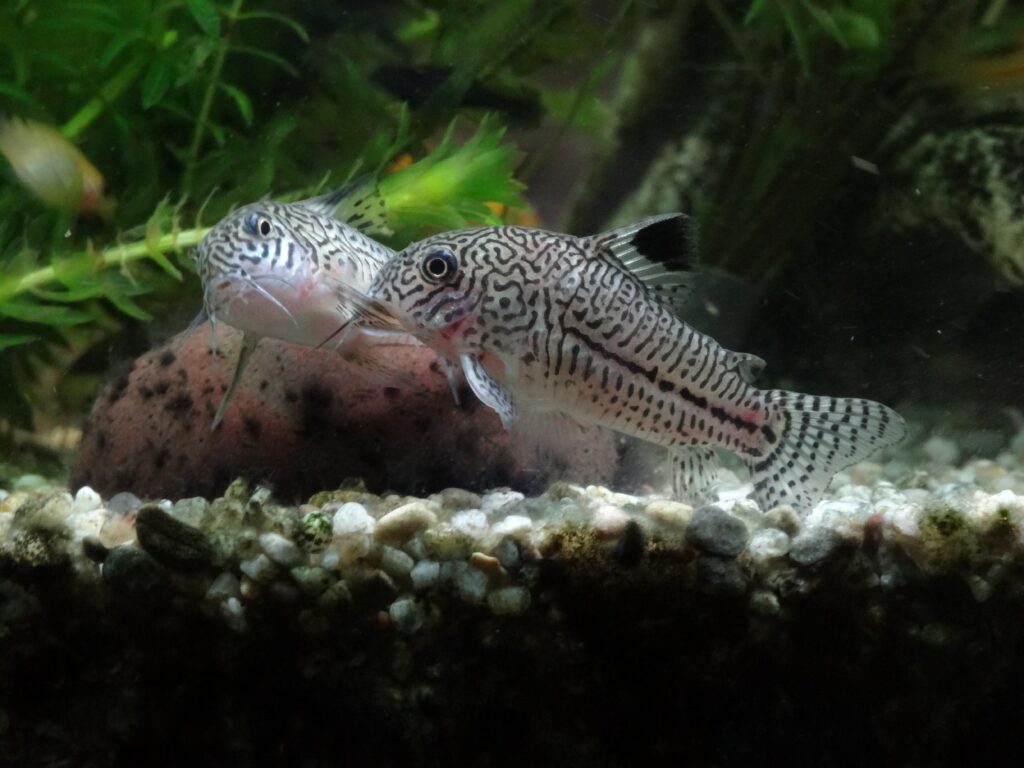
The Julii Cory, often confused with the Leopard Cory, is known for its intricate, leopard-like pattern of fine spots and lines. This small and peaceful species adds a touch of elegance to any aquarium with its delicate features.
Panda Cory (Corydoras panda)
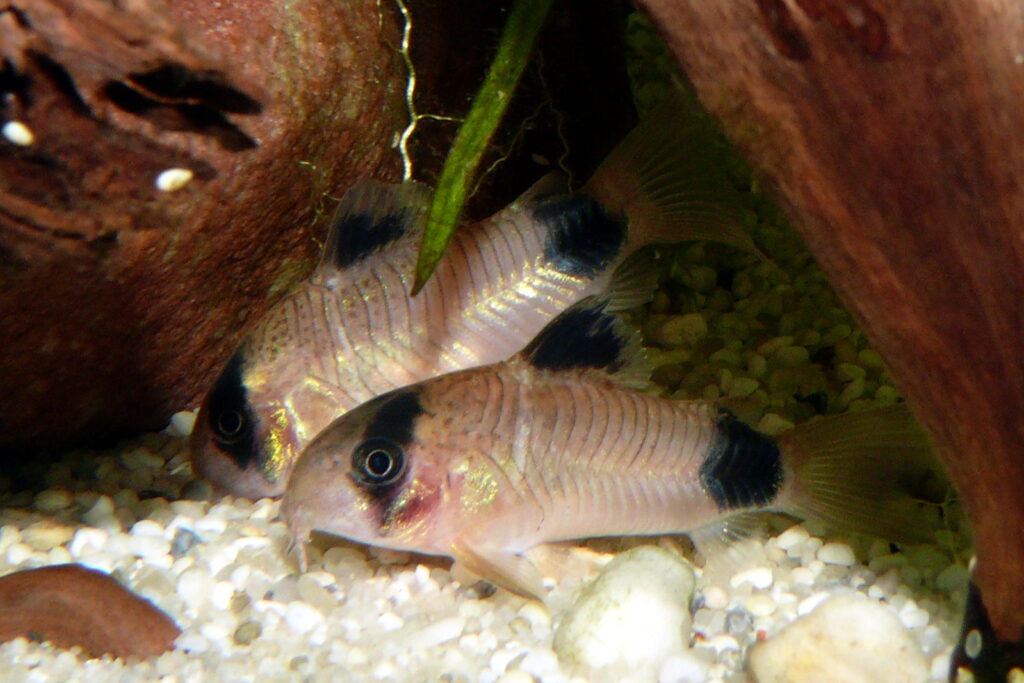
The Panda Cory gets its name from its distinctive black and white coloration, reminiscent of a panda bear. This small, peaceful species is a favorite among aquarists for its playful nature and charming appearance.
Pygmy Cory (Corydoras pygmaeus)
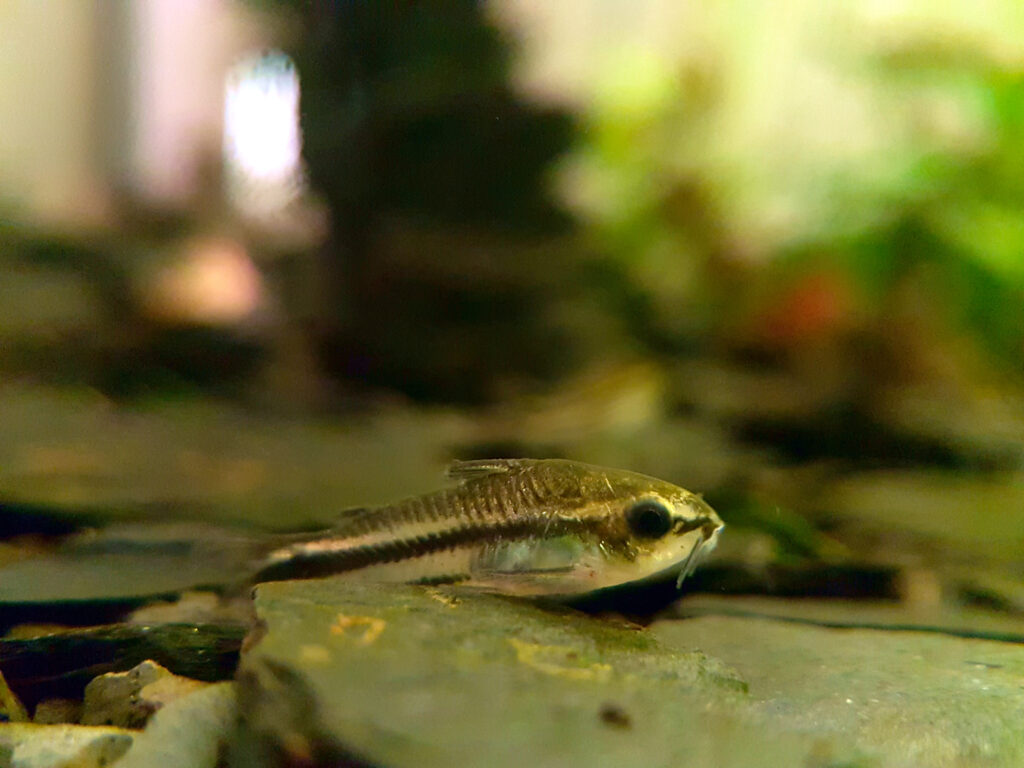
The Pygmy Cory is one of the smallest Corydoras species, rarely growing larger than an inch. Despite its small size, it’s full of personality. This species is perfect for nano aquariums and makes an excellent addition to peaceful community tanks.
Ideal Tank Size and Water Parameters for Corydoras Catfish
Tank Size
Corydoras Catfish are active bottom dwellers that need ample space to swim and forage. The ideal tank size can vary depending on the species and the number of fish, but here’s a general guideline:
- Small Species (like Pygmy Corys): A 10-gallon tank can be suitable for a small group of small Corydoras species.
- Medium to Large Species (like Bronze Corys or Peppered Corys): A 20 to 30-gallon tank is typically recommended for these larger species.
- Multiple Corydoras: Corydoras are social fish that prefer to be in groups of at least 5-6. If you plan to keep a group, you’ll need to increase the tank size accordingly.
Water Parameters
Corydoras Catfish are fairly hardy, but they do best when the water parameters are kept consistent. Here are the ideal water conditions for Corydoras:
- Temperature: Corydoras Catfish prefer a temperature range of 72-78°F (22-26°C). Some species can tolerate slightly cooler or warmer temperatures.
- pH Level: Corydoras do well in slightly acidic to slightly alkaline water, with a pH range of 6.0-8.0.
- Water Hardness: The water hardness should be between 2-25 dGH.
- Ammonia, Nitrite, and Nitrate: As with all fish, ammonia, and nitrite levels should be kept at 0. Nitrate levels should be kept low, preferably below 20 ppm.
- Water Change: Regular water changes are essential to keep the water clean and healthy. A 25% water change every week is usually sufficient.
Stability is key when it comes to water parameters. Sudden changes can stress the fish and lead to health problems.
Lifespan and Full Size of Corydoras Catfish
Lifespan
The lifespan of Corydoras Catfish is quite impressive compared to many other freshwater aquarium species. On average, these fascinating creatures can live for about 5-10 years in a well-maintained aquarium environment. However, this is not a hard and fast rule. Some species, particularly the Bronze Cory, have been known to exceed this average lifespan significantly, with some individuals living for over 15 years and even reaching the ripe old age of 20 in captivity.
The lifespan of Corydoras Catfish is influenced by a variety of factors. A proper diet is crucial – a balanced diet rich in the necessary nutrients contributes to their overall health and longevity. Water quality is another vital factor. Corydoras thrive in clean water with stable parameters. Regular water changes and good filtration can help maintain optimal water conditions. Stress levels also play a role in their lifespan. A peaceful environment, proper tank mates, and plenty of hiding spots can help keep stress levels low. Finally, like all living creatures, genetics can also influence their lifespan.
Full Size
When it comes to size, Corydoras Catfish offers a range of options to fit different aquarium sizes. At the smaller end of the spectrum, you have species like the Pygmy Cory. These petite fish typically only grow to about 1 inch in length, making them perfect for smaller or nano aquariums.
Most Corydoras species fall into the medium-size category. These fish, including popular species like the Peppered Cory and Panda Cory, typically grow to about 2-3 inches in length. They are a great choice for most community aquariums.
Then there are the larger Corydoras species. The Bronze Cory is a good example, often reaching up to 4 inches in length. These larger Corydoras make a bigger impact visually and are well-suited to larger community aquariums.
The size that Corydoras Catfish can reach is influenced by several factors. Diet plays a role – a nutritious, varied diet can support healthy growth. The size of the tank can also impact their growth. Corydoras need plenty of space to swim and forage. Overcrowded conditions can stunt their growth. Lastly, the overall health of the fish can influence their size. Healthy fish are more likely to reach their full-size potential. Regular health checks and prompt treatment of any diseases can help ensure your Corydoras Catfish grow to their full size.
Natural Environment, Behavior, Habitat Preference, and Aquarium Decoration for Corydoras Catfish
Natural Environment
Corydoras Catfish are native to South America, where they inhabit a wide range of freshwater environments. Here’s a closer look:
- Rivers and Streams: Corydoras are commonly found in slow-moving rivers and streams. These environments typically have soft substrates composed of sand or fine gravel, which the Corydoras sift through in search of food.
- Floodplains: Some species also inhabit floodplain areas, which are seasonally inundated with water. These environments often have a rich supply of food.
- Geographical Range: The geographical range of Corydoras spans several countries in South America, including Brazil, Colombia, Peru, and Argentina.
Behavior
Corydoras Catfish exhibit a range of interesting behaviors that make them a favorite among aquarists:
- Social Behavior: Corydoras are highly social fish that prefer to live in groups. They often engage in shoaling behavior, where they swim together in a coordinated manner.
- Feeding Behavior: Corydoras are bottom feeders. They use their sensitive barbels to sift through the substrate in search of food.
- Unique Breathing: Corydoras have a unique ability to breathe air. They can be seen darting to the surface of the water to gulp air, which they can extract oxygen from thanks to a specialized part of their digestive system.
Habitat Preference
In the aquarium, Corydoras Catfish have specific habitat preferences that mimic their natural environment:
- Substrate: Corydoras prefer a soft substrate that they can sift through. Sand or fine gravel is ideal.
- Plants: Live plants can provide additional cover and make Corydoras feel more secure. They also contribute to a healthier aquarium environment by absorbing nitrates.
- Hiding Spots: Corydoras appreciate having plenty of hiding spots. Decorations like caves, driftwood, and rock formations can provide these necessary refuges.
Aquarium Decoration
When decorating an aquarium for Corydoras Catfish, consider the following:
- Substrate: As mentioned, a soft substrate like sand or fine gravel is best. This allows the Corydoras to exhibit their natural sifting behavior without damaging their delicate barbels.
- Plants: Live plants not only provide cover but also contribute to the overall health of the aquarium. Plants like Java Fern, Anubias, and Amazon Sword are all good choices as they are hardy and can tolerate a range of conditions.
- Hiding Spots: Providing plenty of hiding spots is crucial for Corydoras. This can be achieved with decorations like caves, driftwood, and rock formations. These provide the Corydoras with a sense of security and can also enhance the visual appeal of your aquarium.
- Open Swimming Space: While Corydoras spend a lot of time near the bottom, they also need open space to swim. Be sure not to overcrowd the tank with decorations.
Suitable Tank Mates for Corydoras Catfish and Fish to Avoid
Suitable Tank Mates
Corydoras Catfish are peaceful and sociable creatures that get along well with many other species. Here are some suitable tank mates:
- Small Peaceful Fish: Corydoras do well with other small, peaceful fish. Species like Tetras, Guppies, Rasboras, and small Danios make excellent tank mates.
- Other Bottom Dwellers: Other peaceful bottom dwellers can also be a good match. Think along the lines of Loaches and other species of Corydoras.
- Peaceful Mid to Top Dwellers: Fish that occupy the middle or top of the water column can also be a good choice, as they won’t compete with Corydoras for space. Examples include Mollies, Platies, and Hatchetfish.
- Invertebrates: Many invertebrates, such as shrimp and Snails, can also coexist peacefully with Corydoras.
Fish to Avoid
While Corydoras are adaptable, there are some types of fish that they should not be housed with:
- Aggressive Fish: Aggressive species can stress out the peaceful Corydoras. Avoid species like aggressive Cichlids, Arowanas, and large predatory Catfish.
- Large Fish: Fish that are significantly larger than Corydoras could see them as food. Avoid large species like the Oscars, large Plecos, and large Eels.
- Fin Nippers: Species known for fin nipping can cause stress and potential injury to Corydoras. Avoid fish like Tiger Barbs and some species of Tetras.
While these lists provide a general guideline, individual fish personalities can vary. Always monitor new additions to the tank for any signs of aggression or stress.
Best Foods and Diet for Corydoras Catfish
Corydoras Catfish are omnivores, meaning they eat a mix of both plant-based and meat-based foods. Their diet in the wild consists of small invertebrates, plant matter, and detritus. In an aquarium setting, it’s important to provide a balanced diet that mimics their natural food sources as closely as possible. Here’s a detailed look at the best foods and diet for Corydoras Catfish:
Commercial Foods
- Sinking Pellets: Sinking pellets are a great staple for Corydoras Catfish. They are designed to sink to the bottom of the tank, making them accessible for bottom-feeding Corydoras. Look for high-quality pellets that are rich in protein.
- Flake Foods: While Corydoras are bottom feeders, they will often eat flake foods that have sunk to the bottom of the tank. Again, opt for high-quality flakes that offer balanced nutrition.
Live and Frozen Foods
- Bloodworms: Bloodworms are a favorite among Corydoras. They are rich in protein and can be offered live or in frozen form.
- Brine Shrimp: Brine shrimp are another good protein source. Live brine shrimp can also stimulate the Corydoras’ natural hunting behavior.
- Daphnia: Daphnia, or water fleas, are a great source of nutrition. They can be offered live or frozen.
Vegetable Matter
- Vegetable Tablets: Sinking vegetable tablets can provide the plant matter that Corydoras need in their diet.
- Blanched Vegetables: Occasionally, you can offer blanched vegetables like peas, spinach, or zucchini. Make sure to cut them into small, manageable pieces.
Feeding Tips
- Variety is Key: A varied diet is crucial for the health of Corydoras Catfish. Try to rotate different types of food to provide a range of nutrients.
- Avoid Overfeeding: Overfeeding can lead to poor water quality and health problems. A good rule of thumb is to feed only what the fish can consume in 2-3 minutes.
- Feeding Frequency: Corydoras Catfish should be fed once or twice a day. If you have a busy schedule, an automatic fish feeder can be a useful tool.
Breeding Tips for Corydoras Catfish
Breeding Corydoras Catfish can be a rewarding experience, but it does require some preparation and attention to detail. Here are some tips to help you successfully breed Corydoras Catfish:
Sexing the Fish
Before you can start breeding, you’ll need to determine the sexes of your fish. Male Corydoras are usually smaller and slimmer, while females are larger and rounder, especially when viewed from above.
Creating the Right Environment
Corydoras Catfish often breed after water changes, especially when the new water is slightly cooler than the tank water. This mimics the rainy season in their natural habitat, which is often a trigger for breeding.
Diet
Feeding a high-quality, varied diet is crucial when trying to breed Corydoras. Live and frozen foods, such as bloodworms and brine shrimp, can help condition the fish for breeding.
Spawning
When ready to spawn, the female will accept sperm from the male, which she holds in a pouch on her ventral side. She then finds a suitable spot, often on the tank glass or on a plant leaf, and deposits a few eggs which she fertilizes with the stored sperm. This process is repeated until all eggs are laid.
Egg Care
Once the eggs are laid, it’s often best to move them to a separate tank to prevent them from being eaten by other fish. The eggs should hatch in about 3-5 days.
Fry Care
Once the eggs hatch, the fry can be fed infusoria or commercially available fry food until they are large enough to eat regular food. Be sure to maintain excellent water quality in the fry tank.
And there you have it, a comprehensive guide to caring for the delightful Corydoras Catfish. From their charming personalities to their fascinating behaviors, these little fish truly bring a unique touch to any aquarium. Whether you’re a seasoned aquarist or just starting out, the Corydoras Catfish offers a rewarding experience that’s hard to match.
As we’ve explored, their care requirements are straightforward, and their sociable nature makes them a joy to observe. They remind us of the beauty of nature’s diversity, hailing from the tranquil rivers of South America to the cozy corners of our homes.
In the end, the most important thing is to provide your Corydoras Catfish with a safe, healthy, and stimulating environment. With the right care, these little armored swimmers will thrive, bringing you endless moments of joy and wonder. So, here’s to the journey of fishkeeping, filled with learning, discovery, and the simple pleasure of watching our finned friends live their best lives. Happy fishkeeping!
FAQs
How Many Corydoras Catfish Should Be Kept Together?
Corydoras Catfish are social fish that prefer to live in groups. It’s recommended to keep at least 5-6 Corydoras together, but they’ll be even happier in larger groups. Remember, you’ll need a larger tank to accommodate larger groups.
Do Corydoras Catfish Clean the Tank?
While Corydoras Catfish are often seen sifting through the substrate and may eat some algae, they should not be considered a solution for keeping your tank clean. They are not a replacement for regular tank maintenance and water changes.
Why Are My Corydoras Catfish Always Hiding?
Corydoras Catfish may hide if they’re feeling stressed or threatened. This could be due to factors like poor water quality, lack of hiding spots, or aggressive tank mates. Make sure your water parameters are in the correct range, provide plenty of hiding spots, and ensure their tank mates are peaceful species.
Are Corydoras Catfish Nocturnal?
Corydoras Catfish are not strictly nocturnal, but they are more active during dawn and dusk. However, they can adjust their activity patterns and will often be active during the day, especially during feeding times.
Do Corydoras Catfish Need a Heater?
Yes, Corydoras Catfish are tropical fish and require a heater to maintain a stable water temperature. They prefer a temperature range of 72-78°F (22-26°C). Always use a reliable aquarium heater and a thermometer to monitor the water temperature.
Do Corydoras Catfish Eat Snails?
Corydoras Catfish are not known to eat snails and are generally safe to keep in a tank with snails. They primarily feed on the bottom of the tank, sifting through the substrate for food.
Do Corydoras Catfish Need Sand?
While Corydoras Catfish can survive without sand, they do prefer a sandy substrate. They enjoy sifting through the sand in search of food, and a sandy substrate can help mimic their natural environment.
Can Corydoras Catfish Live with Betta Fish?
Yes, Corydoras Catfish can usually live peacefully with Betta fish. They inhabit different areas of the tank (Corydoras stay near the bottom while Bettas stay near the top), and their peaceful nature makes them a good choice for a Betta tank. However, always monitor new additions to the tank for any signs of aggression.
How Often Should Corydoras Catfish Be Fed?
Corydoras Catfish should be fed once or twice a day. They should be given only as much food as they can consume in 2-3 minutes to avoid overfeeding and potential water quality issues.
Can Corydoras Catfish Live Alone?
Corydoras Catfish are social creatures and prefer to live in groups. A lone Corydoras may become stressed and less active. It’s recommended to keep them in groups of at least 5-6 individuals.